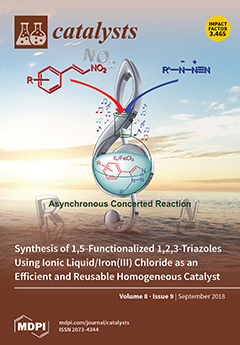In recent years, groundwater contamination caused by dyes has become an important problem. They enter into wastewater as a result of the textile, automotive, or cosmetics industries. For this reason, new methods are being sought, which would aid at the removal of dye
[...] Read more.
In recent years, groundwater contamination caused by dyes has become an important problem. They enter into wastewater as a result of the textile, automotive, or cosmetics industries. For this reason, new methods are being sought, which would aid at the removal of dye impurities with high efficiency and also would be relatively cheap. In the presented study synthesized TiO
2-ZrO
2 (with TiO
2:ZrO
2 molar ratio of 8:2) and TiO
2-ZrO
2-SiO
2 (with TiO
2:ZrO
2:SiO
2 molar ratio of 8:1:1) oxide materials were used as supports for enzyme immobilization. Effective synthesis of the carriers was confirmed by results of scanning electron microscopy (SEM), transmission electron microscopy (TEM), X-ray diffraction (XRD), low-temperature nitrogen sorption and Fourier transform infrared spectroscopy (FTIR). The materials achieve high immobilization efficiency of the laccases from
Trametes versicolor (83% and 96% for TiO
2-ZrO
2-laccase and TiO
2-ZrO
2-SiO
2-laccase, respectively). The effect of selected dye concentrations, pH, temperature, and reusability were also tested. The obtained results showed that after removal of textile dyes, such as Alizarin Red S (ARS), Remazol Brilliant Blue R (RBBR), and Reactive Black 5 (RB5), under optimal process conditions, which were pH 5 and 25 °C, from dye solution of 5 mg/L degradation efficiency reached 100%, 91%, and 77%, respectively, suggesting synergistic mechanism of degradation by simultaneous sorption and catalytic action. Finally, reduction of chemical oxygen demand (COD) of the solution after treatment indicated lower mixture toxicity and effective dye degradation.
Full article





